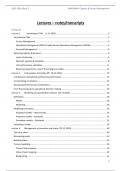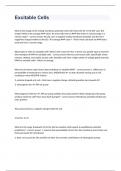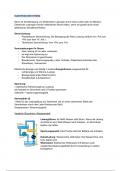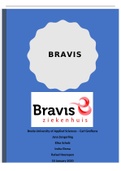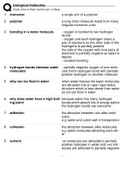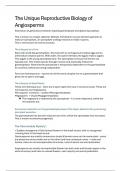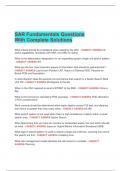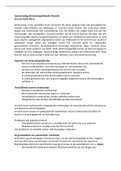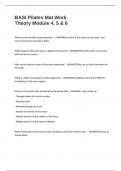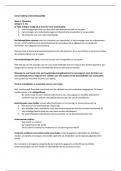Lectures – notes/transcripts
Inhoud
Lecture 1. Introduction CPM (1-12-2023) ............................................................................................ 3
Introduction CPM .......................................................................................................................................... 3
Service Management ................................................................................................................................. 3
Operations Management (OM) & Health Service Operations Management (HSOM) .............................. 5
Financial Management .............................................................................................................................. 6
Balancing capacity & demand ....................................................................................................................... 6
Levels of planning ...................................................................................................................................... 6
Demand, capacity & variability .................................................................................................................. 8
Unit performance: utilization .................................................................................................................. 11
Balancing capacity for a ward: The Erlang Loss model ............................................................................ 15
Lecture 2. Cost analyses and trade-offs (8-12-2023) ............................................................................... 19
Link between operational and financial performance ................................................................................ 19
Incorporating uncertainty ............................................................................................................................ 22
Moving beyond financial considerations ..................................................................................................... 25
From financial goals to operational direction-making................................................................................. 26
Lecture 3. Modelling and quantitative analyses (15-12-2023) ................................................................. 28
Definitions.................................................................................................................................................... 28
Model....................................................................................................................................................... 28
Modelling ................................................................................................................................................. 28
Modelling techniques .................................................................................................................................. 29
Analytical models – Deterministic ........................................................................................................... 30
Analytical models – Stochastic ................................................................................................................ 33
Simulation models – Stochastic ............................................................................................................... 35
Validating a model ....................................................................................................................................... 38
Lecture 4. Management of processes and chains (22-12-2023) ............................................................... 40
The value chain ............................................................................................................................................ 40
Decoupling points ........................................................................................................................................ 43
Bullwhip effect ............................................................................................................................................. 45
Process modelling ........................................................................................................................................ 49
Process flow mapping .............................................................................................................................. 49
Value stream mapping ............................................................................................................................. 49
Blueprinting ............................................................................................................................................. 51
1
,2023-2024, Block 3 GW4018MV. Capacity & Process Management
Process management: Statistical Process Control ....................................................................................... 52
𝑋-chart ..................................................................................................................................................... 53
R-chart ..................................................................................................................................................... 55
Lecture 5. Standardization vs. Customization (12-1-2024) ....................................................................... 58
The Business Model of general hospitals: Comingling ................................................................................ 59
The alternative: Separate & Concentrate .................................................................................................... 60
Causal inference challenges..................................................................................................................... 61
Identifying causal effects through instrumental variables ..................................................................... 62
Trade-offs between customization & standardization for healthcare processes ........................................ 63
2
,2023-2024, Block 3 GW4018MV. Capacity & Process Management
Lecture 1. Introduction CPM (1-12-2023)
We will start with a short summary of basic concepts in Capacity & Process Management, that you may
remember from your bachelor or premaster courses. Two core concepts of this area of research are
Capacity and Demand. One of the main topics for today is how to find a balance between capacity and
demand in health care providing units. Furthermore, we will introduce the design cycle for problem solving.
Targets for this meeting:
• you are able to apply basic concepts of capacity & process management
• you are able to apply the design cycle for problem solving
• you are able to calculate and compare different performance indicators to analyse the performance
of units.
• you can analyse the balance between capacity & demand for a health care unit
• you are able to apply the Erlang Loss model for a health care unit and interpret the results
Introduction CPM
Slide 3
These are the building blocks of the
course: →
Service Management
Slide 4 + 5
Service management: this is broader
than just health services, e.g. service
or a service organization is also: if
you hire a car or eat in a restaurant.
We distinguish between service
management and production &
distribution logistics and operations management.
A service is an activity or series of activities of more or less intangible nature that normally, but not
necessarily takes place in interactions between the customer and service employees and/or physical
resources or goods and/or systems of the service provider, which are provided as solutions to customer
problems. (Gronroos, 1990)
Service management has some specific characteristics, which makes that also the operations management
and financial management principles are a little bit different as compared to e.g. a production environment.
These are the main characteristics that make it distinguishable:
• Intangible: you cannot grab it.
• Non-transferrable ownership: you cannot transfer a service that is delivered to me and then deliver
that service again to someone else. The only thing that you can transfer to someone else is the
resource, e.g. the time slot in an agenda that is assigned to me to receive the service (like a doctor’s
consultation): you can transfer the time slot, but that is not the service! The service is what is
happening within that time slot and this is non-transferable.
• Customer participation: in general, a service is an interaction between a service provider and a
customer (in health services: a patient or a client). So customer participation is required, so the service
takes place between the provider and the customer, this means that the customer needs to be there at
every moment that the service is delivered. E.g. if my service consists of several steps (a first
consultation, an examination, a second consultation, etc.) and every step and activity in that process a
customer needs to be available and present.
3
, 2023-2024, Block 3 GW4018MV. Capacity & Process Management
This is different when you just buy something: e.g. when you buy a car, you don’t have to be present
during the fabrication process, you only have to be there to pick it out and then to pick it up.
For a service, in every step of the production process the customer must be available and must be
there. That gives a lot of challenge to the planning of a process, and that is different from production
organization.
• Simultaneous creation and use: the customer needs to be there at the same time as the service
provider is available for that specific patient. So there is a challenge in planning these kinds of things.
• Heterogeneity: it is also different between different customers and the same service provider. The
interaction also makes the activity, it is part of the content of the service and how it is delivered and
how it is experienced.
• Perishable: we cannot keep services, we cannot put it in stock or as inventory. You cannot use it again
later on.
Slide 6
We see the service as a ‘service package’. At the core we have the service experience: the total of how a
patient experiences the service.
Part of the service is very explicit (e.g. the talk you have with your doctor), but there are also some more
implicit parts (e.g. feeling safe in the hospital or in the hands of the doctor, experiencing a comfortable
temperature in the examination room) that together make how the service is experienced by a patient.
Normally, you do not realize those implicit parts of the service until they are not there anymore (e.g. if you
don’t feel safe or are not comfortable, you realize that something is wrong with the service). So the
difference between explicit vs. implicit parts of the service is whether you can directly see and therefore
experience it, or whether it is more underground and you experience it only when it’s gone.
The outer circle consists of:
• Information: e.g. about your patient process (what is happening when, what do you need to do as
preparation).
• Facilitating goods: this can be every (small) material that is used in the service. E.g. information leaflets,
medical single-use material.
• Supporting facilities: that are the resources that they need to provide this specific service → resources
and facilities that can be re-used again. E.g. the building, a specific room, the equipment they need.
4

